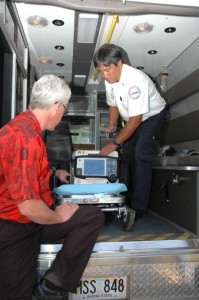MAUI MEMORIAL MEDICAL CENTER FOUNDATION DONATES STATE-OF-THE-ART WIRELESS EKG TO HELP SAVE LIVES
 From the moment a person suffers a heart attack, minutes can mean the difference between life and death. “Now these minutes will be reduced and lives saved thanks to a state-of-the-art wireless EKG,†said officials with the Maui Memorial Medical Center Foundation who donated 12 units worth an estimated $40,000.
From the moment a person suffers a heart attack, minutes can mean the difference between life and death. “Now these minutes will be reduced and lives saved thanks to a state-of-the-art wireless EKG,†said officials with the Maui Memorial Medical Center Foundation who donated 12 units worth an estimated $40,000.
The equipment is being installed in all county ambulances beginning march 2nd, enabling paramedics to transmit diagnostic-quality cardiac data via the internet to the hospital prior to arrival.
This alert system, the Lifenet® STEMI Management Solution, features a unique combination of web, broadband and medical technology aimed at reducing time to treatment for heart attack patients. Queen’s Medical Center was the first hospital in the state of Hawaii to acquire this technology in May 2008.
Agency officials say the technology is a life-net for patients experiencing STEMI (ST-elevation myocardial infarction), a dangerous form of heart attack that impedes or blocks blood flow to the heart. By receiving the patient’s data before they arrive to the hospital, Maui Memorial Medical Center’s medical team will be able interpret the condition sooner, and provide the “clot-buster†medication more rapidly. In the near future, this system will mobilize the cath lab team with their interventional cardiologist, and expedite treatment in an effort to optimize the best outcome for the patient. In this situation, the catch phrase is “Time is Muscleâ€â€”the more time elapses, the more heart muscle dies.
The American Heart Association estimates that nearly 400,000 people in the U.S. experience STEMI every year. Studies have reported a significant relationship between pre-hospital 12-lead EKGs and shorter door to balloon times. Door to balloon time refers to the time a patient enters the hospital until the time reperfusion by balloon angioplasty reestablishes blood flow to an occluded artery, and this is achieved in the cardiac catheterization lab. According to the American College of Cardiology and American Heart Association, 90 minutes or less is the door-to-balloon time recommended to receive treatment.
“With this new EKG device, we hope to achieve optimal door-to-balloon times, save heart muscle, and ultimately more lives,†said Wesley Lo, CEO of Maui Memorial Medical Center. “We are very excited to be using this new technology and are grateful for this donation by the Foundation which benefits our entire community.â€
“This latest technology could not have happened without the generosity of the Florence Foundation whose contribution enabled the Foundation to purchase these EKG wireless units,†said Ululani Correa, executive director of the Maui Memorial Medical Center Foundation. “These communitarians are valued stakeholders in our community as they help us to elevate the quality of healthcare here at home.â€
PHOTO CAPTION: David Russell, R.N., Cardiovascular Services Director for Maui Memorial Medical Center, (pictured left) and Pat Gragas, MICT Paramedic, demonstrate the new wireless EKG which is now fitted in all ambulances in Maui County.
(Posted by Wendy OSHER © 2009)










